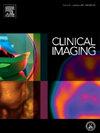Accuracy of visual estimation of embolized splenic volume in N-butyl cyanoacrylate splenic embolization: Insights from a quality assurance study
IF 1.5
4区 医学
Q3 RADIOLOGY, NUCLEAR MEDICINE & MEDICAL IMAGING
引用次数: 0
Abstract
This retrospective quality assurance review evaluates the concordance between visual intra-procedural angiographic estimates and CT-derived volumetric measurements of splenic embolization using n-butyl cyanoacrylate (n-BCA) with tantalum in 15 patients at a single institution. In this internal audit, 3D-Slicer software was used to segment and calculate splenic volumes from pre- and post-procedure CT scans in a series of cases where n-BCA was used for non-traumatic splenic embolization.
The median pre- and post-embolization splenic volumes were 883.32 cm3 [interquartile range (IQR) = 620.52–1234.4 cm3] and 223.68 cm3 [IQR = 34.99–555.25 cm3], respectively. The corresponding median percentage of embolized splenic parenchyma was 78.88 % [IQR = 55.51–90.88 %], compared to a median angiographic estimate of 80 % [IQR = 60–100 %] recorded in procedural documentation.
Correlation analysis between the visual angiographic estimate and volumetric calculations derived from cross-sectional CT scans showed a Pearson correlation coefficient (r) of 0.95 (p < 0.00001) and a coefficient of determination (r2) of 0.90. These findings suggest that intra-procedural visual estimates, as routinely documented by interventional radiologists at our institution, reasonably reflect the splenic embolization extent when using n-BCA.
氰基丙烯酸丁酯脾栓塞术中栓塞脾体积目视估计的准确性:来自质量保证研究的见解
本回顾性质量保证综述评估了同一机构15例患者使用氰基丙烯酸酯正丁酯(n-BCA)与钽进行脾栓塞术的视觉血管造影估计和ct衍生体积测量之间的一致性。在这次内部审计中,在一系列使用n-BCA进行非创伤性脾栓塞的病例中,使用3d切片软件对术前和术后CT扫描的脾体积进行分割和计算。栓塞前后脾体积中位数分别为883.32 cm3[四分位间距(IQR) = 620.52 ~ 1234.4 cm3]和223.68 cm3 [IQR = 34.99 ~ 555.25 cm3]。相应的脾实质栓塞的中位数百分比为78.88% [IQR = 55.51 - 90.88%],而手术记录中血管造影估计的中位数百分比为80% [IQR = 60 - 100%]。通过横断面CT扫描得出的血管造影估计值与容积计算结果的相关分析显示,Pearson相关系数(r)为0.95 (p < 0.00001),决定系数(r2)为0.90。这些发现表明,术中视觉评估,如我们机构的介入放射科医生常规记录的那样,合理地反映了使用n-BCA时脾栓塞的程度。
本文章由计算机程序翻译,如有差异,请以英文原文为准。
求助全文
约1分钟内获得全文
求助全文
来源期刊

Clinical Imaging
医学-核医学
CiteScore
4.60
自引率
0.00%
发文量
265
审稿时长
35 days
期刊介绍:
The mission of Clinical Imaging is to publish, in a timely manner, the very best radiology research from the United States and around the world with special attention to the impact of medical imaging on patient care. The journal''s publications cover all imaging modalities, radiology issues related to patients, policy and practice improvements, and clinically-oriented imaging physics and informatics. The journal is a valuable resource for practicing radiologists, radiologists-in-training and other clinicians with an interest in imaging. Papers are carefully peer-reviewed and selected by our experienced subject editors who are leading experts spanning the range of imaging sub-specialties, which include:
-Body Imaging-
Breast Imaging-
Cardiothoracic Imaging-
Imaging Physics and Informatics-
Molecular Imaging and Nuclear Medicine-
Musculoskeletal and Emergency Imaging-
Neuroradiology-
Practice, Policy & Education-
Pediatric Imaging-
Vascular and Interventional Radiology
 求助内容:
求助内容: 应助结果提醒方式:
应助结果提醒方式:


